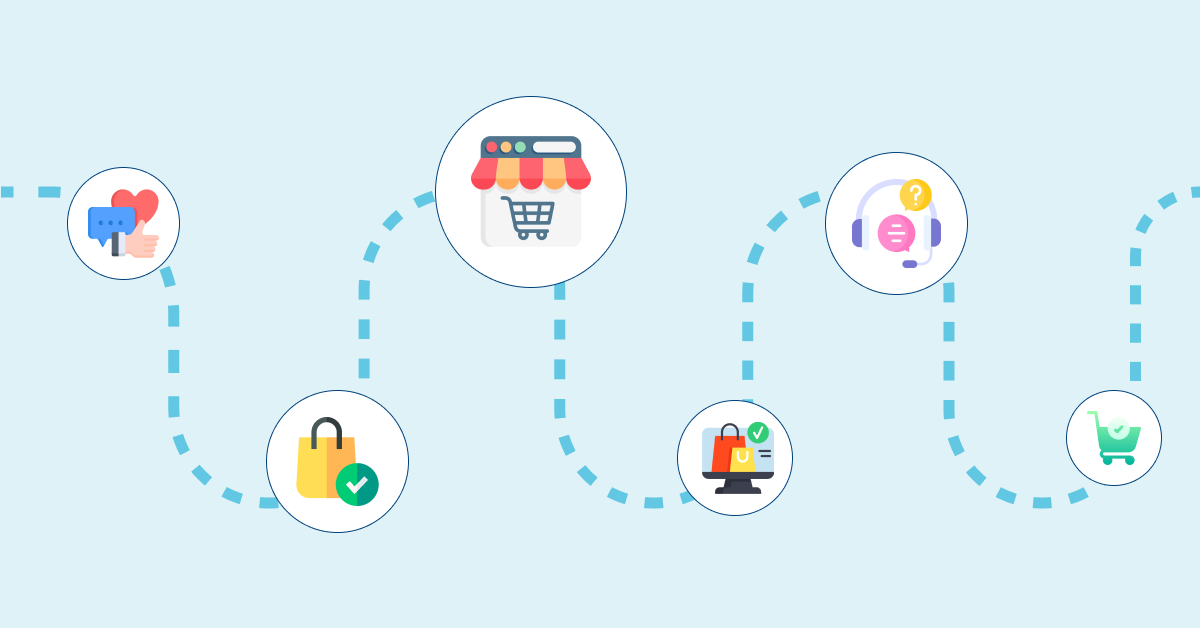1. Understand Your Target Customer
The first step in delivering a unified customer experience is to understand the target customer thoroughly. It includes examining their expectations, preferences and behaviors across all channels.
Let’s take an example of a fashion brand targeting millennials who may focus on creating trendy and visually appealing content for social media platforms like Instagram. The understanding allows for consistent messaging across all touchpoints, enhancing the customer experience and driving loyalty.
Pro tips:
- Collect customer data through surveys, focus groups, social media analytics and other sources. Use it to create buyer personas that represent the ideal customers.
- The buyer personas will serve as the foundation of the customer experience strategy and help to personalize the interactions across different touchpoints.
2. Map the Customer Journey
Businesses need to know precisely what the customers go through when interacting with the brand to deliver unified and exceptional customer experiences. Create a visual customer journey map that illustrates all the touchpoints that the customers have with your business.
Consider the example of a customer journey map that can reveal opportunities to improve communication, streamline processes and enhance customer satisfaction. It identifies pain points and addresses them proactively, resulting in a cohesive customer experience across all channels.
Pro tips:
- The map should include all online and offline interactions they have with the brand, from browsing the website to contacting the customer service team.
- Use the roadmap as a reference for improving customer experience, ensuring that every touchpoint is consistent and personalized.
3. Make Digital Channels a Priority
Customers expect a seamless and personalized experience across all digital touchpoints. Make sure the website, mobile app, social media channels and email campaigns provide an easy-to-navigate experience. Embracing digital channels as a priority is a game-changer for businesses looking to excel in the competitive marketplace.
Brands for example can utilize social media platforms, mobile apps and websites to interact with customers seamlessly across various touchpoints. It not only enhances customer satisfaction but also drives brand loyalty and ultimately boosts business growth.
Pro tips:
- Ensure the digital channels are fully integrated, so customers can easily switch between them without losing context.
- Make it easy for customers to find the information they need and contact the support team if they have questions or issues.
4. Train Your Support Team
The customer support team plays a crucial role in delivering a unified customer experience. Ensure that they are well-trained and equipped to provide comprehensive, knowledgeable answers to customer queries.
Picture a support agent armed with in-depth training, providing not just a solution but a detailed explanation, guiding the customer through every aspect with confidence and expertise. No matter if it’s a technical intricacy or a product feature, a trained support team transforms each interaction into a learning experience for the customer.
Pro tips:
- Give them access to the customer data they need to personalize their interactions.
- Encourage them to be proactive and empathetic when interacting with customers, even if they are under stress.
5. Use Omnichannel Marketing
Omnichannel marketing is a customer-centric approach that aims to provide a consistent and personalized experience across every touchpoint in the customer journey. Solid omnichannel brands witness a 7.5% yearly decrease in cost per contact. Implement the strategy by using a variety of tactics to communicate with customers. The seamless integration of channels ensures that the customer receives a consistent and cohesive experience.
Think of a customer who might come across a product on a company’s website, add it to their cart and then abandon the purchase. The company can send the customer a personalized email with omnichannel marketing to remind them about the solutions or a special discount. The customer then should receive a notification on their mobile app with the same message.
Pro tips:
- Apply data analytics and insights to evaluate the effectiveness of each channel
- Adjust the marketing strategy based on the reporting and analytics to improve customer experience.
6. Personalize Messages and Interactions
Customers appreciate personalized messages and interactions that demonstrate that you understand them. Companies can create a more personalized and engaging experience by tailoring communication to each individual, ultimately building stronger relationships with customers.
Imagine a clothing brand sends a personalized email to a customer, addressing them by their name and recommending products based on their past purchases. It not only makes the customer feel valued but also shows the brand understands their preferences.
Pro tips:
- Use customer data to personalize the emails, promotions and product recommendations to tailor the interactions accordingly.
- Be cautious not to overdo it and make sure the efforts toward personalization are not perceived as intrusive.
7. Use a Single Customer View
Companies must have a single customer view to deliver a unified customer experience. They get a 360-degree view that shows the entire history of each customer’s interactions with the brand across all touchpoints. It creates an integrated picture of each customer’s preferences, allowing them to deliver a seamless and personalized experience every time.
Let’s take the instance of the customer making an online purchase. They later reached out to the support department regarding a concern. The staff will have access to the customer’s purchase history, preferences, and previous interactions with the help of SCV. It allows them to provide personalized and efficient assistance, leading to a seamless experience for the customer.
Pro tips:
- Implement advanced data integration and management tools to ensure up-to-date customer information across all touchpoints.
- Leverage personalization techniques based on the single customer view to tailor marketing messages, offers and interactions to individual preferences.
8. Monitor Customer Feedback and Respond Promptly
Monitoring and responding to customer feedback is essential for delivering a unified customer experience. Analyzing the feedback allows companies to identify patterns, trends, and areas for enhancement. It paves the way for strategic refinements in the solutions or overall customer engagement strategies.
Consider the example of a customer reaching out on social media expressing dissatisfaction with a product. The brand can turn their negative experience into a positive one by swiftly acknowledging their concern, showing empathy and offering a resolution. It not only satisfies the customer but also enhances the brand’s reputation and builds trust among potential customers.
Pro tips:
- Use customer feedback to identify areas of improvement in the customer experience strategy and make the necessary changes.
- Respond promptly to complaints, queries and issues. It shows the brand values their show that you value the customer’s concerns.
Technology Needed for Effective Unified Customer Experience
Check out the essential technologies that can help businesses build a cohesive, engaging and effective unified customer experience.
















